Reading Time: 16 minutes
Table of contents
- What does an international medical flight entail?
- What are the different types of medical flights available?
- Medical training of flight attendants v/s medical flight doctors: Adequate Medical Flight Assistance before, during and after a flight.
- Medical Air Service: what about our medical flight doctors?
- A medical professional on a commercial flight
- Why would you need a medical flight?
- How much does a medical flight cost?
- Are medical flights covered by insurance?
- Medical flight cost: Alternative payment and funding options to contribute to your medical flight fee
- Benefits of booking a domestic or international medical flight
- Why should you book a medical flight with Medical Air Service?
- How to book a medical flight with Medical Air Service?
- Are our customers happy with us? Testimonials and Google Reviews
- Contact us for a medical flight worldwide
Whether in urgent or non-emergency patient transport situations, medical flights have become a fundamental part of the travel sector. In recent years, especially with the COVID-19 pandemic, we saw a rapidly growing and frequent need for aeromedical services.
In short, medical flights involve any type of aircraft, whether commercial planes, helicopters or private jets, on which patients can enjoy added benefits in terms of medical facilities. This ensures that they can fly from one location to another, short haul or long haul, without compromising on their health.
Medical tourism has also been a major driver for air ambulances. More and more people are seeking more advanced medical treatment that is not available in their home country. In a lot of cases, these patients are not fit enough to fly commercially, because of their fragile health, a specific condition that cannot handle the change in cabin pressure or because of an injury causing them to be immobile and requiring a stretcher.
Whether you are an explorer or a homebody, it is important to be aware of what medical flights are, how useful they are and how to book one.
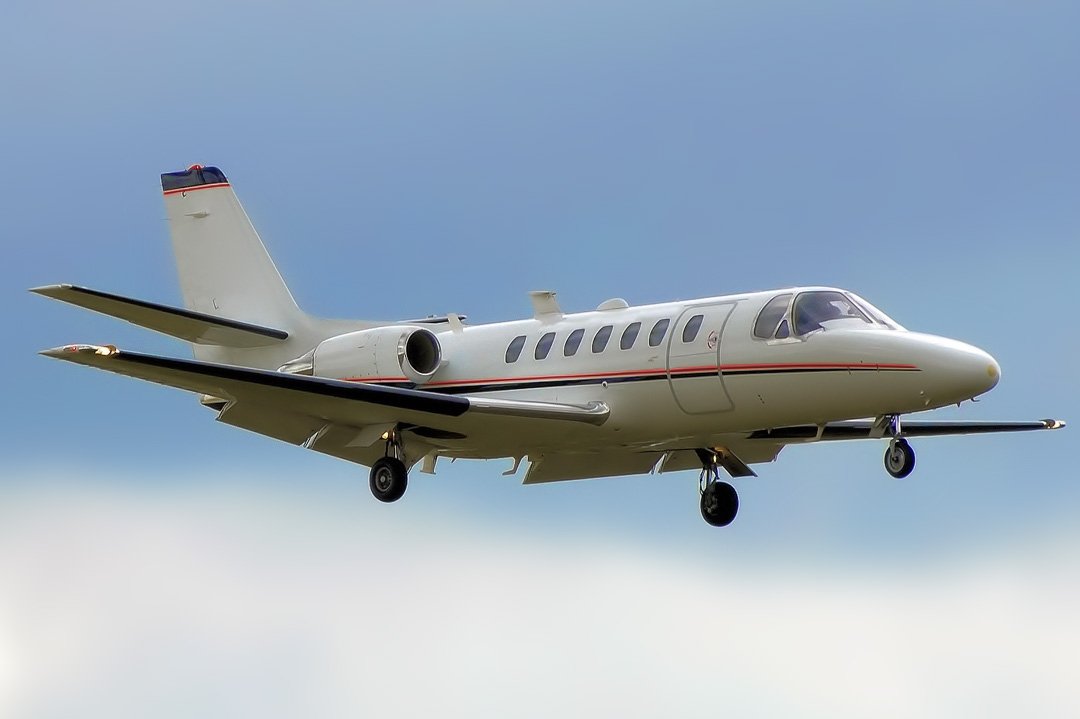
What does an international medical flight entail?
A medical flight involves flying on an aircraft on which travelers can benefit from medical assistance from trained professionals. They are mainly used to transport patients for short or long distances.
The major marker of a medical flight is the level of treatment and care provided to the patient on the aircraft. Airline staff on a commercial airliner are trained to offer first aid treatment only in case of an emergency. However, some passengers with a pre-existing medical condition need a more advanced level of supervision or care, especially during long-haul flights. This is where medical flights come in.
Is there medical staff on the plane?
Medical supervision or medical assistance entails having a medical professional, someone who is trained in identifying medical issues and delivering the necessary care. Is this a benefit offered on medical flights? Yes.
Depending on the type of medical flight you opt for, you will be able to travel with medical professionals, such as flight doctors and paramedics, who are trained in aviation medicine. This means that patients can fly without worrying about possible emergencies mid-flight.

Can you bring medications on planes?
This is one of the main questions that patients have. Will they be able to bring their medications on the plane with them while traveling to another destination?
In the majority of cases, these medications are essential for the well-being , if not the survival, of the patient, especially for long-haul flights. Considering this, if the proper patient transportation regulations are followed, you are able to bring medication on commercial airliners. For instance, the medications should always be in their original and labeled packaging, you should have a doctor’s prescription and you must check the country regulations where you are traveling to.
When it comes to medical flights, the situation varies based on the option you have selected. For instance, flying on a commercial airliner implies that you have to follow the regulations of the airline company. In contrast, when traveling on a private jet or a dedicated air ambulance, you would have more freedom when it comes to the medication allowed on board.
What are the different types of medical flights available?
One common misconception that people have is that there is only one type of medical flight for patients, irrespective of their medical condition or situation. At Medical Air Service, being aware that no two situations are the same and that each patient has a specific set of needs that have to be met, we offer different types of medical flights. They are:
- Air ambulance planes (including both Turboprop Planes and Jets)
- Medical escorts on commercial flights (Stretcher Flights)
- Ambulance helicopters
Air ambulance planes
When it comes to long-distance patient transportation, air ambulance planes are the most efficient and most commonly used option. In contrast to ambulance helicopters, they can travel longer distances at a much quicker rate.
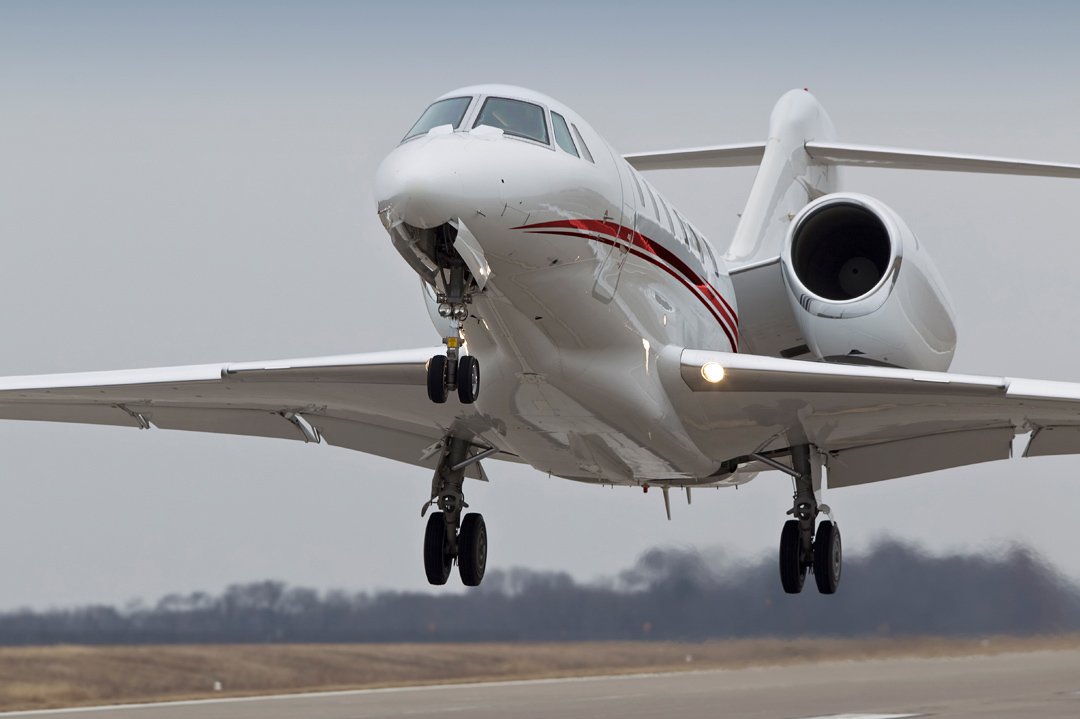
Air ambulance planes are essentially private jets that are fitted with medical equipment. At Medical Air Service, we make sure that the equipment is similar to an Intensive Care Unit (ICU) ensuring that we can transport patients requiring intensive care.
On board our air ambulance planes are doctors and paramedics who are going to care for patients and provide treatment in case of a medical emergency throughout the flight. They operate worldwide and can transport patients to and from anywhere across the globe. As such, they are the most appropriate option if you have a medical condition but you wish to fly long distances both for medical evacuations and medical repatriations.
Commercial medical escorts
Patients with a stable medical condition and who can handle more strain than others, while still requiring some form of medical supervision, can opt to fly commercially with a medical escort. Since they are flying on a scheduled flight, the cost is lower than a private air ambulance. However, this medical flight option involves several conditions.
- The patient must be fit to fly in a commercial plane, which implies enduring the troubles of check-in procedures. However, he will be helped by the medical escort.
- The airline company has to give its approval for the patient transport which may take a couple of days. (Refusing access to the patient is within the airline company’s rights)
- There are some limitations in terms of the level of privacy that can be enjoyed by the patient throughout the medical flight.
- The medical escort is limited in its capacities when it comes to the medical equipment or medication allowed on board the plane.
Traveling with a medical escort means that you will be accompanied by a medical professional, who will supervise your medical condition and assist you, but also act as a companion who is going to reassure and comfort you throughout the flight.
This medical flight option is perfect for the elderly, among other patients, who are anxious about traveling or are weaker and need extra help but have no one to fly with them. At Medical Air Service, we make sure to select a medical escort whose personality matches that of the traveler, ensuring a pleasant flight for everyone involved.
Ambulance helicopters
With movies and TV shows displaying helicopters as being the most common, if not the only, type of aircraft used to transport patients, especially from accident scenes to medical facilities, most people with a medical emergency seek these when making travel plans.
Ambulance helicopters are, in real life too, used to transport patients from one location to another. Like in the movies, they are fitted with medical equipment and have doctors and paramedics on board to provide emergency treatment and care.
Nonetheless, ambulance helicopters are used for short-distance transportation only because of their range and speed. They are appropriate for domestic transfers across the US or for transfers across the border area between two countries.
Important to note: The ambulance helicopters of Medical Air Service do not conduct emergency operations such as transporting patients from the site of an accident to hospitals but can be used for shorter country-to-country or state-to-state medical flights distance permitting.
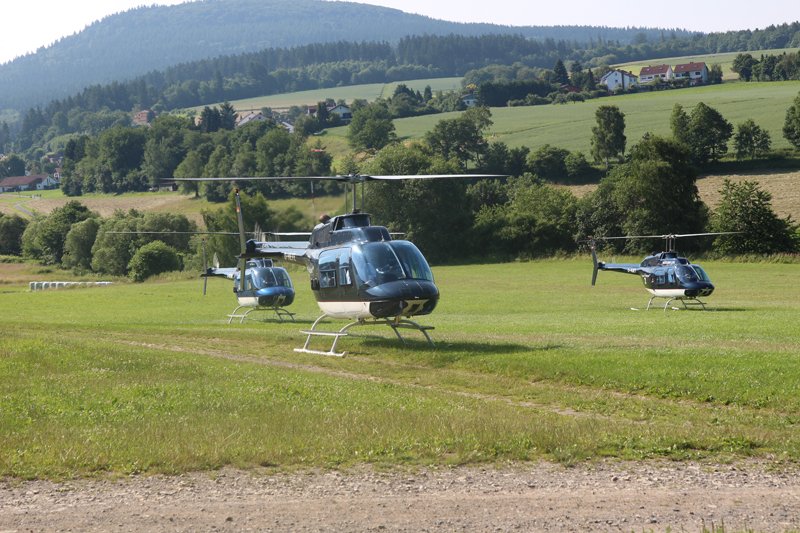
Our air medical flights are customized according to the patient’s condition
Besides offering different types of flights that the patient can choose from, we make sure to serve his needs by customizing the patient transport as much as possible. After a consultation session, our aviation experts will work on the best solution for your needs. If you have any medical emergency that requires special equipment or specialist doctors, we will make sure to bring in the amenities required.
For instance, when transporting babies and infants, we can equip our planes with pediatric incubators. These are incubators designed to ensure maximum safety and comfort for babies, protecting them from external factors that would cause them harm and maintaining environmental conditions suitable for their development and growth.
COVID-19 medical flights
In light of the coronavirus pandemic, we rolled out special incubators to transport patients with a positive COVID-19 test without infecting others on board. Thanks to these isolation incubators, travelers who got infected with coronavirus while being abroad are able to travel back to their home country instead of remaining in isolation all alone to recover in a foreign country where most of the time, they do not have anyone alongside to offer moral support.
Most of the time, our COVID-19 patient transport system operates in the following way:
- If the patient does not have any symptoms, he will travel on his own in a private jet
- Those demonstrating symptoms of the coronavirus travel in the isolation incubator in an air ambulance plane. Doctors and paramedics onboard will oversee his condition and administer treatment if needed via special ports in the incubator throughout the medical flight.
In both cases, we take all the precautions necessary to ensure that others involved in the patient transport process are not at risk of a potential infection.

Medical training of flight attendants v/s medical flight doctors: Adequate Medical Flight Assistance before, during and after a flight.
A major marker of medical flights is the medical staff present on these planes to ensure the safety of the patient on board. Instead of the usual cabin crew, consisting of air hostesses and flight attendants, air ambulances are staffed with doctors and paramedics. Let’s explore the difference between these two different entities.
Do flight attendants have medical training?
The major task of flight attendants is to ensure that passengers are comfortable and safe during the flight. When we speak about safety here, it implies making sure that passengers are aware of and following all the necessary protocols, such as remaining seated during landing and take-off, wearing their seatbelts or, considering the COVID-19 pandemic, wearing their face masks, among others.
Their duties also extend to making sure that equipment and supplies needed for the flight are available and properly operating and to handling any problem that might arise during the flight.
To that effect, when flight attendants are employed, they receive the necessary training on customer service, boarding processes, pre-flight safety protocols, in-flight service and first aid care.
Considering the fact that in most cases commercial flight attendants have first aid training, they will be able to deal with minor medical problems, should they occur during the flight. Some examples of the medical issues that they are trained to handle are:
- Dizziness
- Lightheadedness and fainting
- Minor respiratory problems
- Flight anxiety
- Allergic reactions
- Nausea
However, it is important to note that the level of medical training received by flight attendants is extremely limited and they would not be able to offer the appropriate treatment or care in case of a more serious medical emergency.
Medical Air Service: what about our medical flight doctors?
In contrast to the staff on commercial flights, the air ambulances of Medical Air Service are staffed with trained and experienced flight doctors and paramedics. How can they help you out during an emergency?
First of all, as the term itself suggests, flight doctors are qualified and trained to offer medical treatment and care. Just like doctors in a hospital, their job is to take over the responsibility of the patient’s health. In the case of an air ambulance flight, their role is to monitor the patient’s condition, to ensure that it is stable and to provide emergency treatment and care if needed.
Considering the environmental differences between a flight and a medical facility, the flight doctor has to undergo even more extensive training in the aviation medicine field ensuring that they are qualified enough to offer treatment in the limited space available in an ambulance flight.
Additionally, thanks to their years of experience, our air ambulance doctors have developed the expertise and skills, such as situational awareness, efficient communication or rapid decision-making, necessary during an intervention mid-flight.
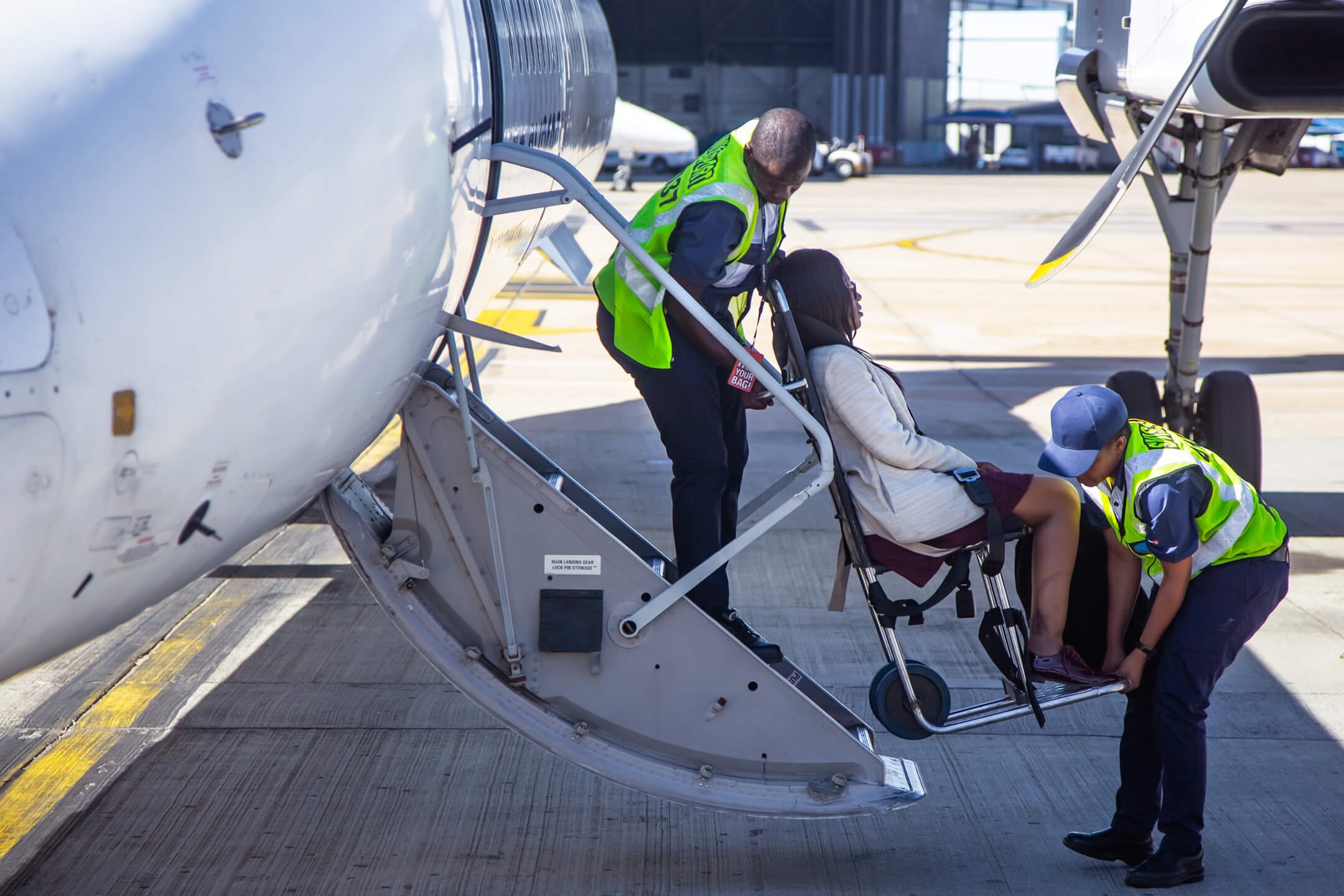
Taking complete care of your safety and offering maximum comfort, we go a step above and call in specialist doctors whenever required. For instance, if the patient has a special medical condition that needs a higher level of medical attention. This is also applicable for babies and infants in which case we have pediatric doctors on board.
A medical professional on a commercial flight
We ensure world-class medical flight assistance throughout your medical flight transport. Thanks to our medical escort service, you can enjoy the perks of a medical professional on a commercial flight. When choosing this option, you will be accompanied by a doctor or paramedic who is going to take care of you during the flight. This involves monitoring your medical condition and intervening in case of an emergency.
Why would you need a medical flight?
The major motive behind the booking of a medical flight is, in most cases, the traveler has a medical condition that might aggravate if he flies. In some cases, he can fly commercially on the condition that he is medically supervised and in others, his condition is not strong enough to board a commercial flight. There are several reasons that prevent flying commercially and require medical evacuation or medical repatriation on a medical flight.
Medical evacuation and medical repatriation
Medical evacuation and medical repatriation both involve patient transportation to another location on a medical flight. How exactly do we define those terms? What is the difference between medical evacuation and medical repatriation?
To put it simply, medical evacuation involves a patient traveling out of his home country to another one to obtain higher level medical treatment or to be close to a loved one who has moved abroad.
Medical repatriation involves getting back to your home country on a medical flight, generally when you have experienced a medical emergency abroad. You may want to get back home because the level of treatment and care available locally is inadequate or to be closer to your family members.
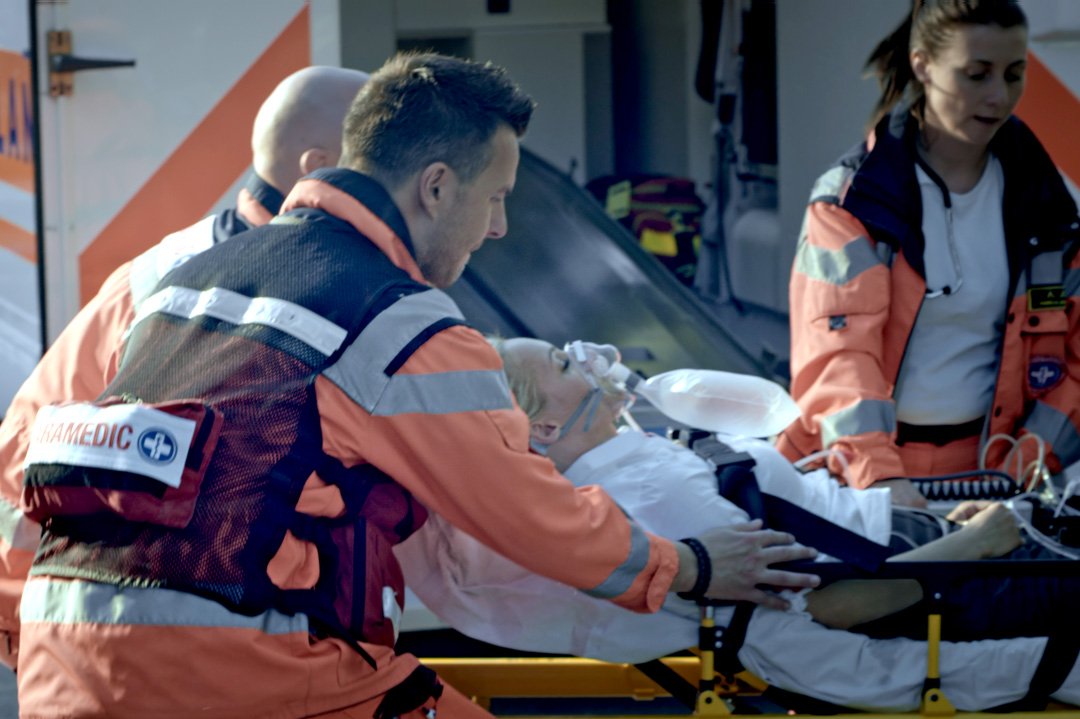
In both cases, because of his medical condition, the patient cannot sustain flying like a normal passenger on a commercial flight. What are some of the reasons that prevent someone from boarding a plane?
When an injury prevents you from flying commercially
Flying with minor injuries such as scrapes, cuts or minor bruises is usually possible. Flying is not possible with bigger injuries because of the risk of trapped air.
One of the possible risks of an injury is having air trapped in tissues surrounding the injury or beneath the skin (in the subcutaneous tissue). The medical term for this condition is subcutaneous emphysema.
If you have an injury with trapped air and you intend to board a flight, you are more likely to experience pain and more complications mid-flight. This is because as the plane will reach a higher altitude, the air pressure inside the cabin will decrease causing gasses (the trapped air) within the body to expand, causing further complications.
While healthy passengers will experience harmless side-effects such as ‘jet bloat’, the medical condition of those will an existing injury might be considerably exacerbated. Injured patients should also be careful of DVT since the risk of blood clots occurring is higher.
In any case, it is always recommended to take the advice of your doctor if you are injured to determine whether you are fit to fly or not.
When an illness prevents you from boarding a flight
An illness may prevent a passenger from flying commercially for varying reasons depending on the nature of the disease.
In cases of infectious diseases, even if your medical condition is stable enough to fly commercially, the airline company might prevent you from boarding the plane to prevent the risk of infecting others (both passengers and airline crew) and spreading the disease. A prime example would be the coronavirus, which had put a hold on flying for quite some time. Even today, a traveler showing noticeable signs of a COVID-19 infection might be prevented to board a plane.
Other diseases disallow flying because of the risk to the patient himself. Various medical conditions either cannot sustain a commercial flight due to the change in air pressure and other factors or require the patient to be constantly connected to a medical device so that his health remains stable. For instance, this would be the case for last-stage cancer patients. The problem with commercial flying in these situations is that some medical appliances are not allowed on board a commercial flight. This decision lies with the commercial airline company, who might take some time to deliberate whether to allow the medical equipment on board or not.
It should be noted that depending on the risk to the patient’s health, the airline company might refuse to have the patient onboard its plane.
When flying commercially after surgery is impossible
All patients who have undergone a surgery must wait for some time before flying to avoid potential post-operative complications. This amount of time varies depending on the type of surgery undergone. The major risks of flying commercially after surgery are an infection, blood clots and Deep Vein Thrombosis (DVT).

An infection may occur if the surgical wound has not been healed properly, during which time you must be extremely careful about germ transmissions. Considering that flying involves sitting for a long period of time in a closed and cramped space, the risk of infection is heightened.
All surgery patients are at risk of clotting for up to 4-6 weeks after surgery, which is heightened by the act of traveling, especially during long-haul flights. Two factors increase the risk of blood clots during a flight: passengers remaining idle for a considerable amount of time and the dryness of the recirculated air on planes. Blood clots and deep vein thrombosis (DVT) can be fatal in case the clots travel to the lung and causes a pulmonary embolism.
When you cannot fly commercially because you are immobile?
While it is true that certain commercial airliners offer the possibility of traveling on a stretcher for patients who are immobile, there are several complications linked to this option.
First of all, the areas to and from which you can fly are pretty limited, considering the fact that certain airliners allow a stretcher on their plane and for select routes only. As such, the probability of obtaining a flight for your particular destination is quite improbable. If you are in the US, it should be noted that flying on a stretcher is usually not possible on domestic flights.
Secondly, in the event you do find a flight, the organizational process is quite a complicated one. It requires contacting the airline company well in advance and constant communication with all the parties involved for efficient coordination and the bed-bound patient’s safety. In a lot of cases, considering the logistical complexity, the airline company might refuse to have the patient onboard.
Tip: This is where our medical escort service can help. Once you get in touch with us, we take over the complete organizational process of the medical flight, which also getting a stretcher installed on a commercial airliner, depending on your medical condition.
Moreover, there are certain medical complications that are linked to a patient’s being immobile for a long period of time and these can be aggravated by flying commercially, not to mention the exhaustion and physical weariness linked to the act of traveling.
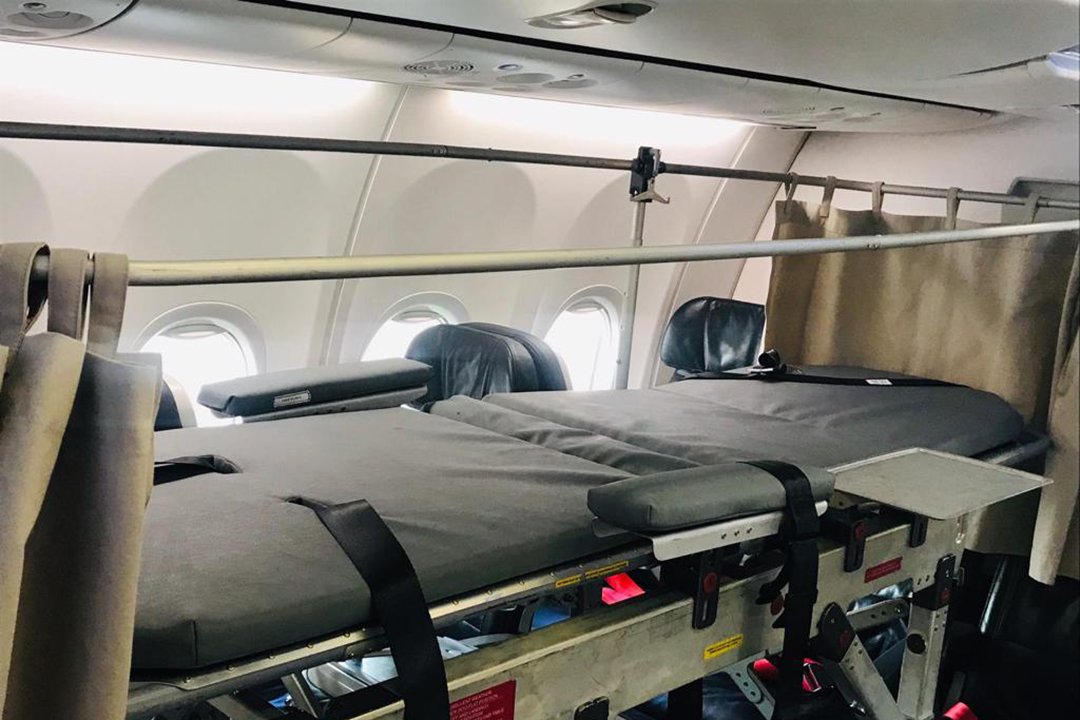
How much does a medical flight cost?
Despite the complexities of the situations mentioned above, you will likely be able to fly safely mainly through one of our to medical flight options. Whether you have to travel on a stretcher on a commercial plane or on an air ambulance jet, our aviation agents will be able to organize the whole process for you. Now comes the question: how much do medical flights cost?
At Medical Air Service, the medical flight cost is calculated individually for each patient while taking into consideration the particularity of each case. This is to avoid any overcharge for any services that you might not need. Thus, when you get in touch with us, our aviation experts will calculate a customized quote for you based on several factors related to your situation.
How is your medical flight quote calculated? The following factors are taken into consideration:
- The route: this is related to the distance that needs to be covered from your current location to your destination
- The size of the aircraft: Bigger aircraft (which some patients prefer for added comfort or to allow more accompanying passengers) are more expensive
- Additional medical equipment or specialist doctors that may be required depending on the patient’s medical condition
- The urgency of the mission: Having a few days to plan the journey gives us the opportunity to coordinate different missions and reduce the medical flight cost.
Are medical flights covered by insurance?
One of the most common questions that is often asked during our consultation sessions is: ‘Will my insurance company cover the medical flight cost?’.
Generally, the insurance company makes a clear demarcation between a ‘medically necessary’ or a ‘medically reasonable’ repatriation and if you have standard travel insurance or medical insurance, this is going to determine whether the medical flight costs will be covered.

Medically necessary repatriation is when the patient cannot obtain adequate treatment in his current location and traveling back home is a necessity to obtain the necessary care for recovery. Considering the gravity of the situation, in this case, the medical flight cost is generally covered by the insurance company.
A medically reasonable case would be when the patient is able to access necessary treatment and care while being abroad and recovery is possible but the results would be better if the patient is transferred back home. In this situation, it is crucial to review your insurance policy since not all medically reasonable repatriations are covered.
Important note: In both cases, it is important to get in touch with your insurance company before assuming that the medical repatriation will be covered. Generally, the insurer will go over your case to determine whether the medical flight is necessary or reasonable.
When getting your travel insurance, make sure to review the policy carefully to ensure that medical repatriation is covered in case of an emergency abroad. If you do not notice any clause in that regard, you can ask your insurer for a travel insurance policy with repatriation coverage.
Does Medicare cover medical flights
If you are in the US, you might be wondering whether Medicare covers medical flight costs or do you need a separate private insurance as a contingency plan.
In most cases, Medicare is going to favor the use of ground ambulances considering that the cost would be considerably lower. However, the eventuality of the medical flight cost being covered by Medicare should not be eliminated.
Depending on certain conditions and based on the Medicare Plan that you have, 80% of the air ambulance cost might be covered. Some of the conditions are:
- The repatriation should be medically necessary, requiring urgent or specialized treatment
- A ground ambulance cannot be used because of the distance, time or other obstacles such as heavy traffic related to the ground transport.
- The air ambulance is in line with Medicare-approved air transport requirements
- If you are in a rural area, you are eligible for medical flight coverage if a medical professional advances that the transport is medically necessary.
Medical flight cost: Alternative payment and funding options to contribute to your medical flight fee
What happens if your insurance company does not cover the medical cost? Can you fly in an air ambulance if you do not have insurance coverage? The answer is Yes! At Medical Air Service, your safety is our priority and we will transport you to where you can get the necessary treatment even if you are not covered by insurance.
In that case, the medical flight cost will be out-of-pocket, which means that you will have to pay for the air ambulance yourself. The payment can be done via a bank transfer, credit card or in cash at our headquarters in Germany.
Alternatively, you can consider reaching out to NGOs or launching a crowdfunding campaign on platforms such as GoFundMe, CoFund Health, Ketto or Tree of Hope, to fund the medical flight. A lot of our clients have experienced success with these two options and many a life has been saved.
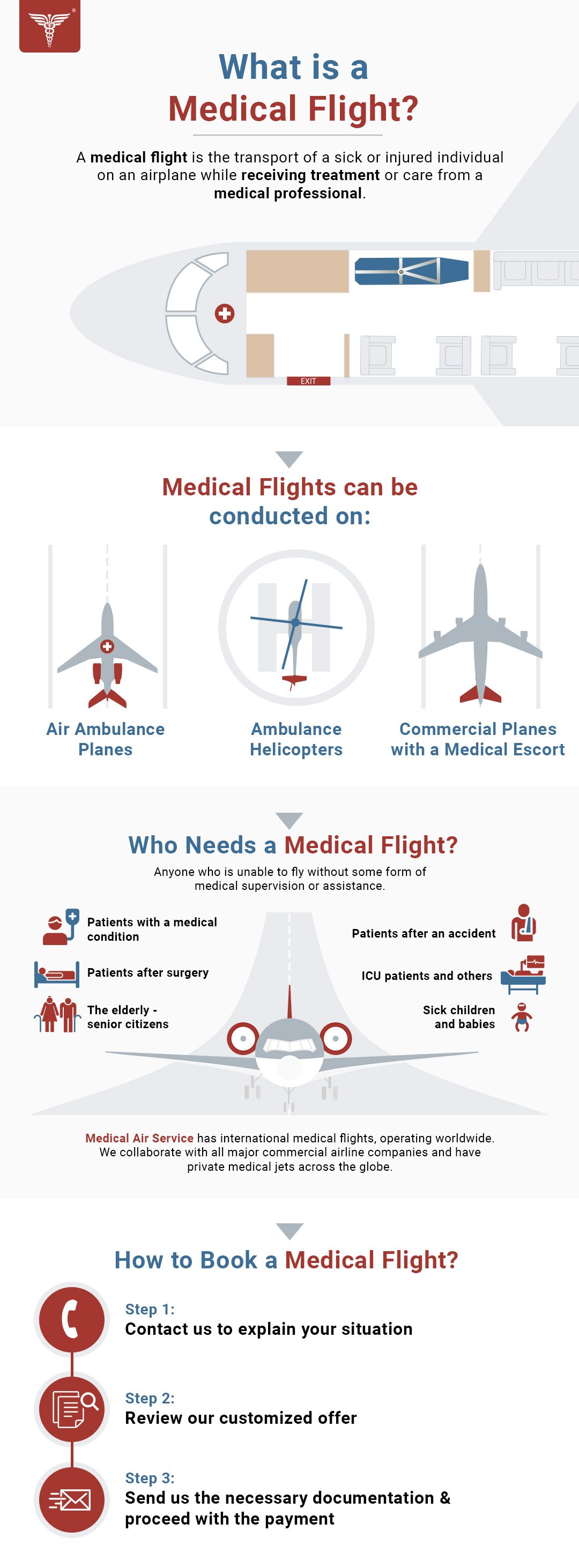
Benefits of booking a domestic or international medical flight
The benefits of booking a medical flight are many and despite the fact that they may be more costly than a regular commercial flight, all of our clients agree that the advantages outweigh the cost. In fact, in many cases, they are a necessity, allowing a patient to travel when it was thought to be impossible.
What are some of the benefits of a medical flight?
- Patient safety is ensured thanks to the high-quality medical equipment and specialist doctors onboard the flight. Air ambulances can also fly at sea level which is mandatory for certain conditions.
- Fast: In contrast to ground transportation, medical flights are considerably faster, allowing for the patient to reach his destination quickly, without putting any additional strain on his condition.
- Efficient: With air ambulances, you can choose both the start and destination date according to your location and schedule. As such, you have more flexibility when it comes to choices, being able to select an airport that is closer to your location or a more recent departure date, which increases the efficiency of the whole patient transport.
- Private: Medical flights in the form of air ambulances offer more privacy in contrast to commercial flights since they are dedicated to the patient only.
Why should you book a medical flight with Medical Air Service?
Moreover, Medical Air Service, a firm offering medical flights for more than a decade offers a whole set of additional advantages to ensure that patients can enjoy the smoothest patient transfer possible. Our goal is to provide patients with the ultimate safe, comfortable and stress-free medical flight possible. To that effect we:
- Offer free consultation sessions with our aviation experts. Experienced in the domain, they will advise you for free on the best type of medical flight for your situation.
- Take over the whole organization process. As soon as you get in touch with us, we start working on your case and we make all the necessary arrangements for the medical flight, relieving you of any form of mental stress. You do not have to worry about getting permits and other such tasks because we will handle everything.
- Operate worldwide. Even if you are on a remote island, we can pick you up and take you back home or to a hospital with higher-quality treatment and care.
- Are available 24/7 to work on your case, making sure the medical flight can take place as soon as possible and constantly updating you.
- Provide a bed-to-bed service: which means that we organize ground transportation to and from the airport ensuring the patient is safe all throughout the patient transport process.
- Allow one person to accompany the patient for free if possible.
- Constantly leverage new technologies to ensure that patients are always safe.
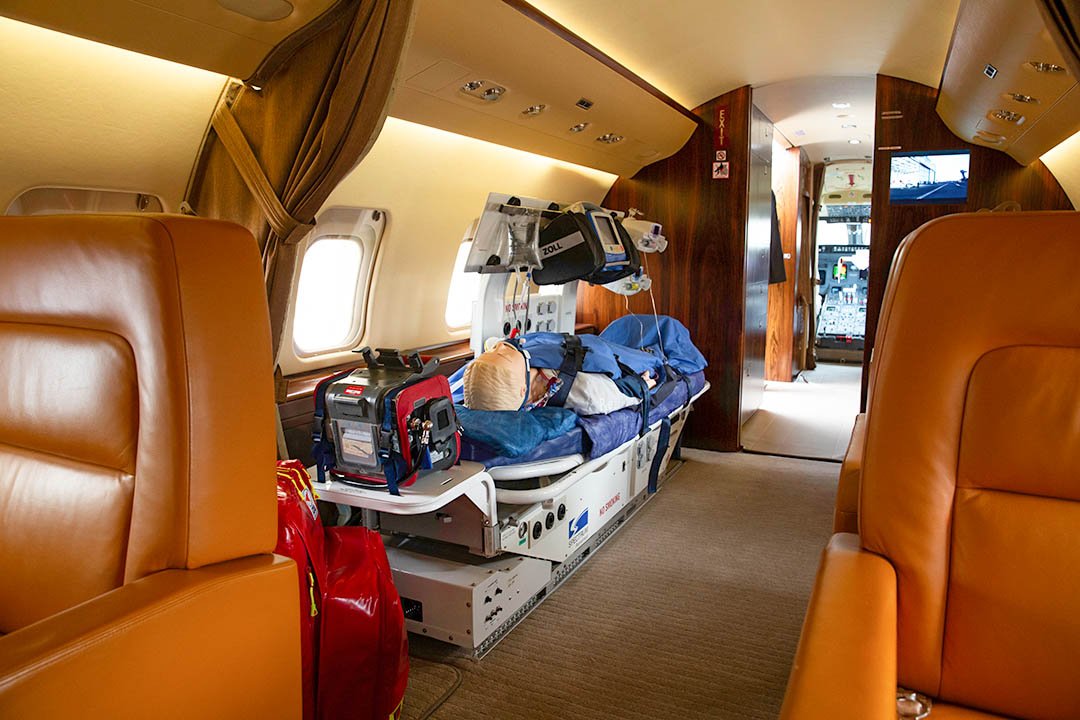
How to book a medical flight with Medical Air Service?
The booking process with Medical Air Service is extremely simple and straightforward. You do not have to worry about lengthy steps and having to go through time-consuming tasks that would drain your energy.
To book a medical flight with us, you just need to:
- Get in touch with us: You can either call, send us an email, use the contact form on our website or have a chat with one of our agents via the chatbox on our website.
- Review the quote: Based on your situation, our agents will work on a customized quote for you, which you can take some time to review and discuss with your family members.
- Send us the necessary documents (if required): In some cases, certain documents such as your passport, a visa or a medical certificate determining your fitness to fly are needed.
After that, we will take care of everything. After getting the permits and making the necessary arrangements, we will send you a flight plan detailing the time and date of your medical flight.
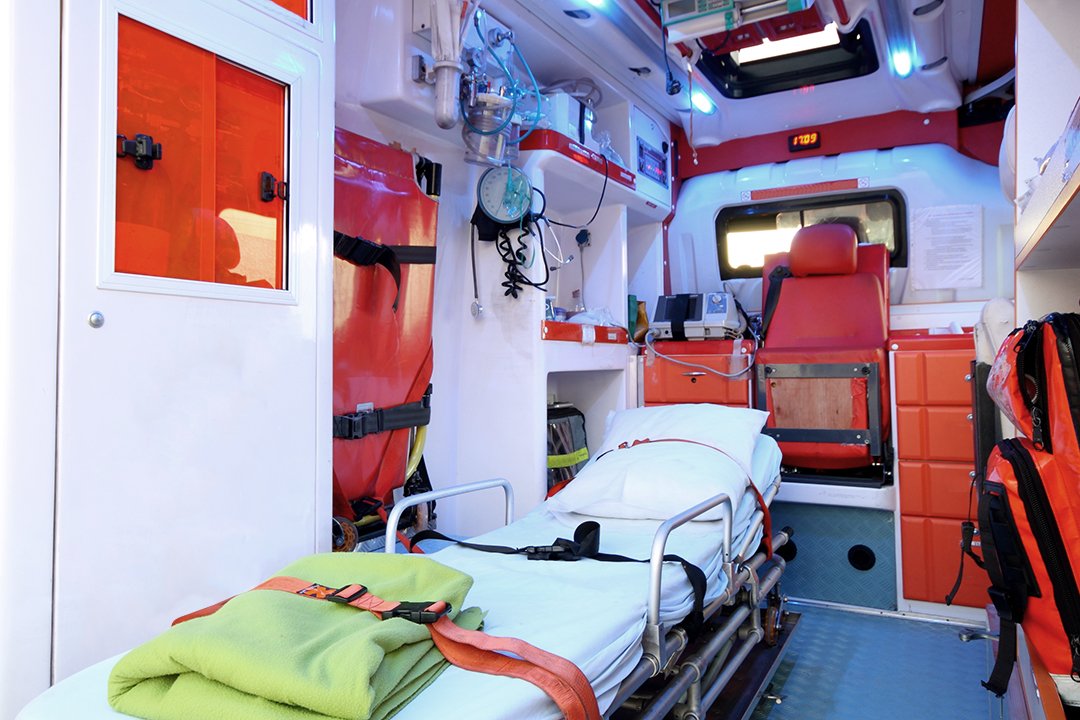
Are our customers happy with us? Testimonials and Google Reviews
Planning a medical flight can be stressful: You do not want to get anything wrong and you want to deal with a company offering the best experience. Our previous customers will clear all your doubts, if you have any, about booking a medical flight with us. Check out some of their testimonials or our Google Reviews if you need reassurance about the way we operate:
“The service was absolutely flawless, our patient was repatriated within 3 days of initial contact and the whole operation was extremely professional.”
“I would say thank you so much for your hard work and support in the last few weeks! You have set a great example for the rest of the world's companies in great communication and cooperation and in the speed of your response in receiving any request.”
“I just want to say a very big thank you to all involved with this, The service was excellent and communication through the process was amazing.
This was a hard complex job with lots of moving parts on a remote island during a pandemic.
My 2 crew members had commented to me how professional your team was on the aircraft.
It was a pleasure working with you all, Amazing job well done!
I can’t thank you enough!”
Contact us for a medical flight worldwide
Whether you need an emergency or non-emergency medical flight, wherever you are across the globe, get in touch with us. We promise patient safety, rapidity and efficiency. Our agents will listen to you, advise you on the best patient transport option based on your needs and being completely transparent, will design a customized medical flight quote for you. Contact us now.
Get in touch now